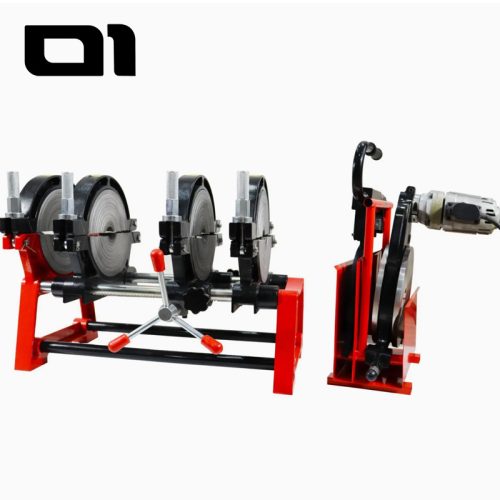Choosing the right welding machine is crucial for any piping project. PPR and PE welding machines are popular choices in the industry. But what sets them apart?
PPR and PE refer to different types of plastic materials used in pipes. Each has unique properties and applications. Understanding these differences is key to selecting the right machine.
PPR welding machines are often used in plumbing and heating systems. They are designed for specific tasks and materials. On the other hand, PE welding machines are common in gas and water distribution.
This article will explore the differences between PPR and PE welding machines. We’ll cover their applications, advantages, and the welding techniques they use.
Understanding PPR and PE: Materials and Applications
PPR stands for Polypropylene Random Copolymer. It’s a durable plastic material used in piping systems. PPR pipes are known for their ability to withstand high temperatures and pressure. This makes them ideal for hot water and heating systems.
PE, or Polyethylene, is another type of plastic used in pipes. It’s widely recognized for its flexibility and resistance to chemical corrosion. High-Density Polyethylene (HDPE) is a common form of PE. It’s especially valued for its high strength-to-density ratio.
The different applications include:
- PPR: Suitable for home heating and plumbing
- PE: Ideal for underground water and gas pipelines
- HDPE: Preferred for its strength in larger installations
Both materials require welding machines that cater to their unique properties. Each has specific characteristics that influence their use in various projects. Understanding these differences aids in choosing the appropriate welding machine for the job.
What Is a PPR Welding Machine?
PPR welding machines are specialized for welding PPR pipes. These machines ensure secure and leak-free connections in plumbing systems. Their design complements the heat resistance of PPR pipes.
PPR welding machines typically employ socket welding techniques. This involves inserting the pipe into a socket and applying heat. It’s a method that ensures strong bonds.
Key features of a PPR welding machine include:
- Heat Adjustment: For precision welding
- Compact Design: Ideal for tight spaces
- Durable Components: Withstands high temperatures
Operators of PPR welding machines require skill and knowledge. Proper training ensures effective operation and safety. Additionally, maintenance of these machines is critical to prolong their lifespan and enhance performance.
What Is a PE (HDPE) Welding Machine?
PE welding machines specialize in joining polyethylene pipes, especially HDPE types. These pipes are preferred for their flexibility and strength. They’re crucial in gas and water distribution networks.
A common technique used with PE welding machines is butt welding. This method involves aligning and heating the pipe ends, then pressing them together. The resulting joint is strong and seamless.
Key components of a PE welding machine include:
- Powerful Heating Elements: For efficient fusion
- Digital Controls: Ensure precision and reliability
- Robust Construction: Suitable for various environmental conditions
Operators of PE welding machines must be knowledgeable about different welding techniques. Training and certification are often required to operate these machines effectively. Proper maintenance and adherence to safety standards are essential for optimal performance and safety.
Key Welding Techniques: Socket Welding vs. Butt Welding
Welding techniques determine the strength and integrity of pipe joints. Two prominent methods are socket welding and butt welding. Each has its own set of applications and advantages.
Socket welding is commonly used with PPR pipes. This technique inserts one pipe into the socket of another pipe or fitting. Heat is applied to fuse them together, creating a reliable bond.
Advantages of socket welding include:
- Ease of Use: Suitable for small diameters
- Less Equipment Required: Simpler setup
Butt welding, on the other hand, is prevalent with PE pipes. It involves heating the ends of two pipes before pressing them together. This creates a seamless and durable joint.
Key benefits of butt welding are:
- Strong Joints: Ideal for high-pressure systems
- Versatile: Suitable for various pipe sizes
Selecting between socket and butt welding depends on pipe material, diameter, and system requirements. Both techniques are critical to modern piping systems, ensuring reliable and efficient installations.
Main Differences Between PPR and PE Welding Machines
PPR and PE welding machines are designed for specific pipe materials. Understanding their differences helps in choosing the right tool for the job.
A PPR welding machine is typically used for socket welding. It is ideal for PPR pipes due to its ability to handle high temperatures and pressure. This makes it well-suited for plumbing and heating systems.
Conversely, PE welding machines are often used for butt welding. They are particularly effective for HDPE pipes. These machines excel in fusing large diameter pipes common in gas and water distribution.
Key differences include:
- Pipe Compatibility: PPR machines work best with PPR pipes, while PE machines are tailored for PE pipes.
- Welding Technique: PPR favors socket welding; PE is aligned with butt welding.
- Application Scope: PPR machines are frequent in plumbing; PE machines dominate in infrastructure projects.
Considering these distinctions assists in deploying the most effective machinery for specific applications.
Conclusion: Which Welding Machine Should You Choose?
Choosing between PPR and PE welding machines depends on your project needs. Consider the pipe material and application demands before deciding.
Each machine type offers unique strengths, tailored for specific conditions. For example, PPR machines excel in high-temperature environments. On the other hand, PE machines offer flexibility and are well-suited for underground installations.
Ultimately, the right choice ensures efficiency and system integrity. Evaluating these factors helps in making an informed decision. This will lead to successful and reliable piping installations.









